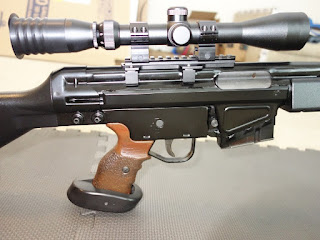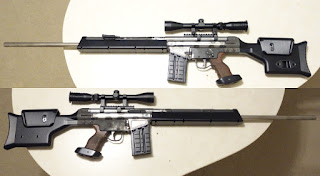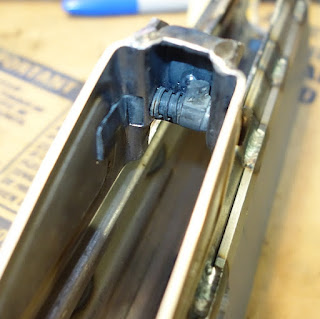I didn't use a punny title for this post because I'm an attention whore and a descriptive title will pop up better in Google searches. This post is going to be all about the 3D printed stock set that I designed for my CETME based PSG-None project. I'm going to assume that if you're here you know how to print and finish parts so I won't go into detail on that, but it's still going to be a long post(see my previous post on how to make your prints look like not prints HERE). Also keep in mind that these are not identical to actual PSG-1 parts, they are just a close approximation. The few necessary HK G3 parts(primarily the recoil assembly) are easy to get and fairly cheap as surplus. It was actually cheaper to buy a used recoil assembly with a green surplus stock than it was to buy the recoil assembly alone. This will also help with your 922r parts count too, as long as you print these in the US.
We'll start at the back and work our way forward. The buttstock is made to work with a standard G3 recoil assembly, G3 recoil buffer, and wood stock G3 sling hardware. I got surplus wood stock sling hardware kit from RTG. It was much rustier that the pic, but was also cheap, so I cleaned up the parts and cold blued them. I cut the pin tubes in half using a jewelers saw because the kerf is only .015" wide and wouldn't remove much material. I used JB Weld to bond the hardware into the stock

The comb on the stock is adjustable. The comb has a big tab on the bottom and the stock has a matching slot to keep things in alignment. It's not spring loaded like a real PSG-1, but it doesn't really need to be. It attaches and adjusts with a single 1/4" screw. In this pic you can also see the two 1/2" holes in the back of the stock for some 1/2" hardwood dowels. Superglue works best for gluing the dowels in place. On the print, you'll probably have to chase the holes with a 1/2" drill bit for the dowels to fit.

I took some liberties with the buttpad and decided to attach it with screws instead of the spring clips found on real HKs. The holes are sized for 10-24 countersunk screws. It is also non-adjustable. It's printed in Ninjaflex TPU flexible filament to help absorb some of the recoil. The recoil assembly attaching holes are also sized for 10-24 screws, and it is made to also use the large screw that goes into the buffer from the back side. Here's how it looks all together(I haven't decided how I want to finish the cheekrest yet, so it's still a raw print, and I need to replace the cheekrest bolt with a button head 1/4-20).


Next up is the pistol grip. The palm rest is adjustable for both height and angle. You can see how I printed the textured part HERE. It will probably take a little fitting to work with your trigger housing as CETME's aren't exactly known for their precision tolerances, and I've never tried it on a G3 lower. The palm rest hole is sized for a 10-24 socket head screw, through on the left side, and threading into the right side.


The next piece isn't part of the stock, but it is printed so I'll include it with this set. The real PSG-1 uses an expensive Hensoldt scope with a rubber bellows. I am using a cheap scope, and it didn't look right without the bellows, so I made one. It will fit on any scope with a 39mm diameter rear eyepiece. It MUST be printed in TPU flexible material, otherwise you'll break your face when it recoils. The file is made to print in Vase mode with 0 top/bottom layers so it's only 1 wall thick. Any thicker than that and it will be too rigid. It's also got a separate base piece that should be set to non-vase and 100% infill to be used with Cura's Per-Model settings, similar to how the fuzzy skinned grip above was set up. If you want to be clever and not use the Per-Model method, you can sink the model so that the base flange below the bed, then use 10-15 brim lines on the print to get a similar, all be it thinner, result.

The last piece is the handguard. The stock and grip will for with either HK or CETME rifles, but the handguard is CETME specific because they use different cocking tubes. This will also work with CETMEs that have the triple frame installed on the barrel if you want the MSG-90 look, or you just don't want to semi-permanently modify your pre-built rifle. The handguard won't sit as far back on the receiver and may have a bit more wiggle in it, but it will still work. This thing is long enough that it gets printed in 3 pieces. This handguard makes the barrel free floating(unless you have a triple frame installed). The pieces of the handguard have holes in them for 1/4" hardwood dowel to align things and hold them together. Like the stock, superglue is the best adhesive to use here. Because I have a tendency to shoot until my gun is very hot, I bent up some aluminum sheetmetal to wrap around the inside and act as a heatshield so I don't accidentally melt my stock. The handguard attaches to the cocking tube with a 1/4" countersunk screw, and an expanding wellnut wrapped in electrical tape inserted into the cocking tube. It's not a great solution and I'll probably come up with something better in the future, I just haven't gotten that far yet. If all else fails, a standard 1/4" nut can be JB Welded into the end of the cocking tube.


So, how's it look with everything assembled? Not too bad. A lot of little tweaks left to do, but it's mostly done at this point. I still have to find or make a shorter 5rd mag for it(they are available, but spending $25 on a 5rd mag when surplus 20rd's are only $5 just grates against my cheapness). I'm going to get some lower scope rings for it too, these tall ones are just what came with the scope and I just don't like them. I still need to paint it obviously and that may take a while because it's too cold in the garage to paint, and the air compressor hose won't reach to the basement. I haven't decided exactly which paint I'm going to use yet either, I think I might try something new.
Basic print settings:
Buttstock, grip pieces, and handguard: 7 walls and 15% Gyroid infill, Textured grip section Per-Model settings of 1 wall, 0 top/bottom layers, and Fuzzy Skin turned on.
Buttpad: I used Ninjaflex TPU with 4 walls and 15% infill.
Scope bellows: TPU, vase mode, 0 top/bottom layers, Base flange Per-Model setting with Vase off and 100% infill.
Thingiverse link, finally:
https://www.thingiverse.com/thing:4787497


















































